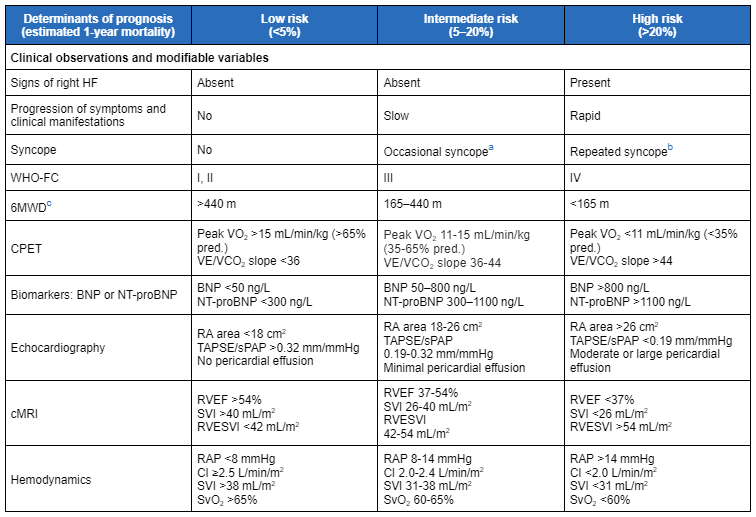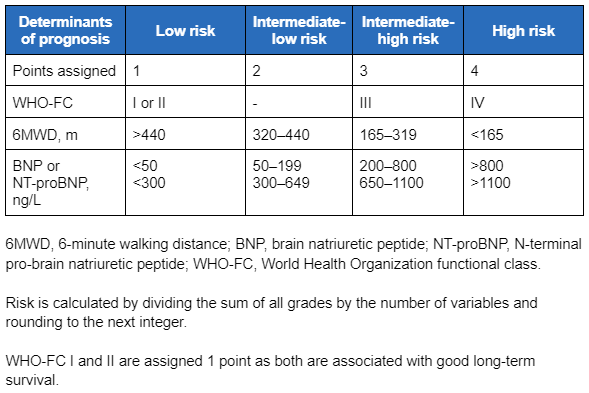Criteria
New York Heart Association (NYHA)/World Health Organization (WHO) classification of functional status of patients with pulmonary hypertension[53]
Functional class I: patients with pulmonary hypertension in whom there is no limitation of usual physical activity; ordinary physical activity does not cause increased dyspnea, fatigue, chest pain, or presyncope.
Functional class II: patients with pulmonary hypertension who have mild limitation of physical activity. There is no discomfort at rest, but normal physical activity causes increased dyspnea, fatigue, chest pain, or presyncope.
Functional class III: patients with pulmonary hypertension who have a marked limitation of physical activity. There is no discomfort at rest, but less than ordinary activity causes increased dyspnea, fatigue, chest pain, or presyncope.
Functional class IV: patients with pulmonary hypertension who are unable to perform any physical activity and who may have signs of right ventricular failure at rest. Dyspnea and/or fatigue may be present at rest, and symptoms are increased by almost any physical activity.
Risk assessment in pulmonary arterial hypertension[3]
The European Society of Cardiology(ESC)/European Respiratory Society(ERS) guidelines highlight a combination of clinical, functional, and hemodynamic measures as a tool to stratify risk of mortality at 1 year.[3]
The ESC/ERS guidelines recommend a three-strata model for risk assessment at the time of diagnosis, using categories of low, intermediate, and high risk of mortality at 1 year. This is used to assess survival and guide management.[3][54]
[Figure caption and citation for the preceding image starts]: Comprehensive risk assessment in pulmonary arterial hypertension (three-strata model). 6MWD, 6-minute walking distance; BNP, brain natriuretic peptide; CI, cardiac index; cMRI, cardiac magnetic resonance imaging; CPET, cardiopulmonary exercise testing; HF, heart failure; NT-proBNP, N-terminal pro-brain natriuretic peptide; PAH, pulmonary arterial hypertension; pred., predicted; RA, right atrium; RAP, right atrial pressure; sPAP, systolic pulmonary arterial pressure; SvO2, mixed venous oxygen saturation; RVESVI, right ventricular end-systolic volume index; RVEF, right ventricular ejection fraction; SVI, stroke volume index; TAPSE, tricuspid annular plane systolic excursion; VE/VCO2, ventilatory equivalents for carbon dioxide; VO2, oxygen uptake; WHO-FC, World Health Organization functional class. a: Occasional syncope during heavy exercise or occasional orthostatic syncope in a stable patient. b: Repeated episodes of syncope even with little or regular physical activity. c: Observe that 6MWD is dependent upon age, height, and burden of comorbidities.European Heart Journal. 2022 Oct 7;43(38):3618-731; used with permission [Citation ends].
During monitoring and follow-up after initial therapy, the ESC/ERS guidelines recommend a four-strata model, which uses categories of low, intermediate-low, intermediate-high, and high risk to guide treatment decisions.[3]
[Figure caption and citation for the preceding image starts]: Variables used to calculate the simplified four-strata risk-assessment toolEuropean Heart Journal. 2022 Oct 7;43(38):3618-731; used with permission [Citation ends].
Use of this content is subject to our disclaimer